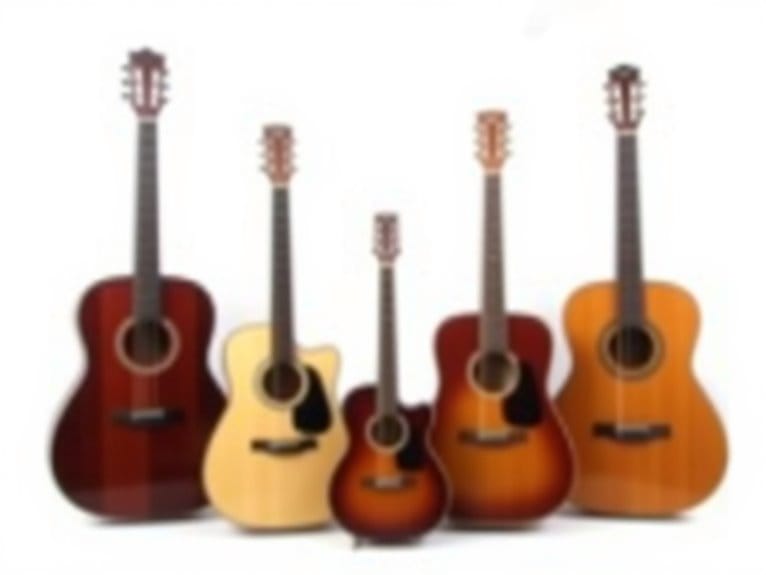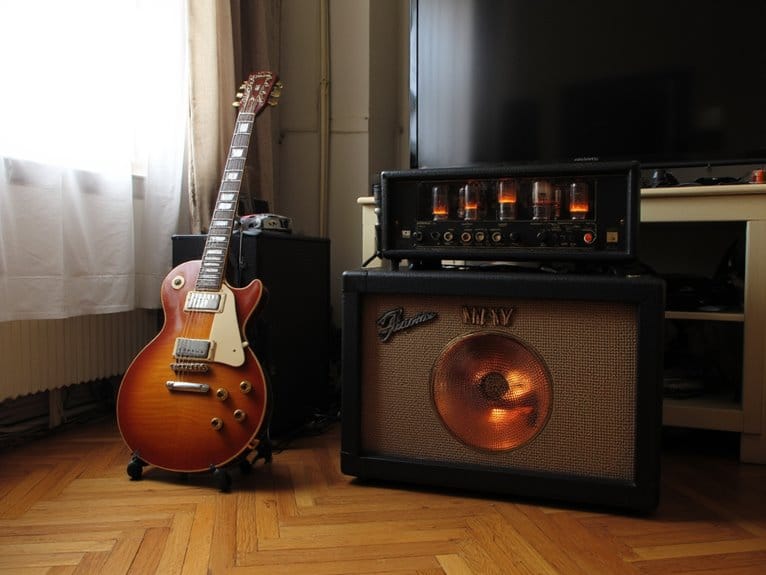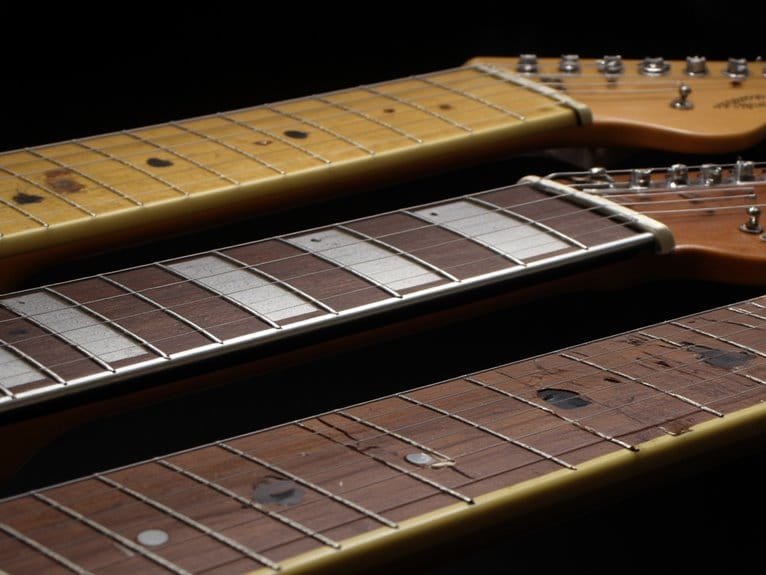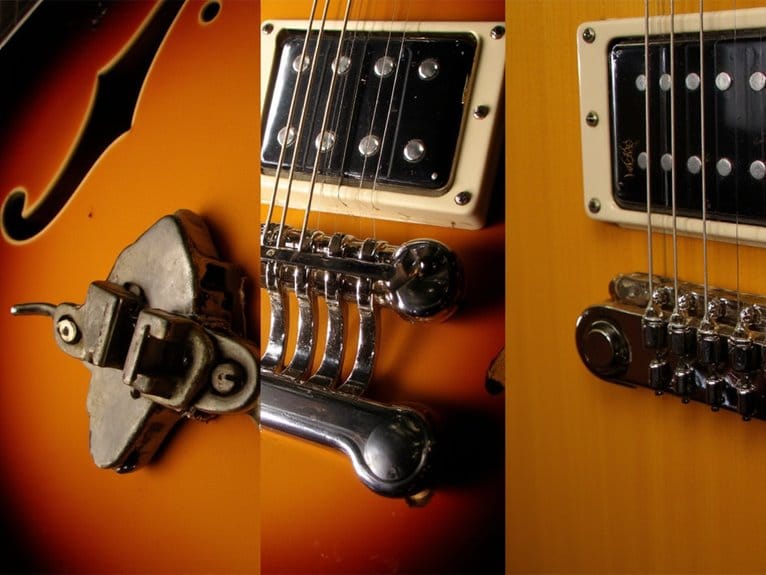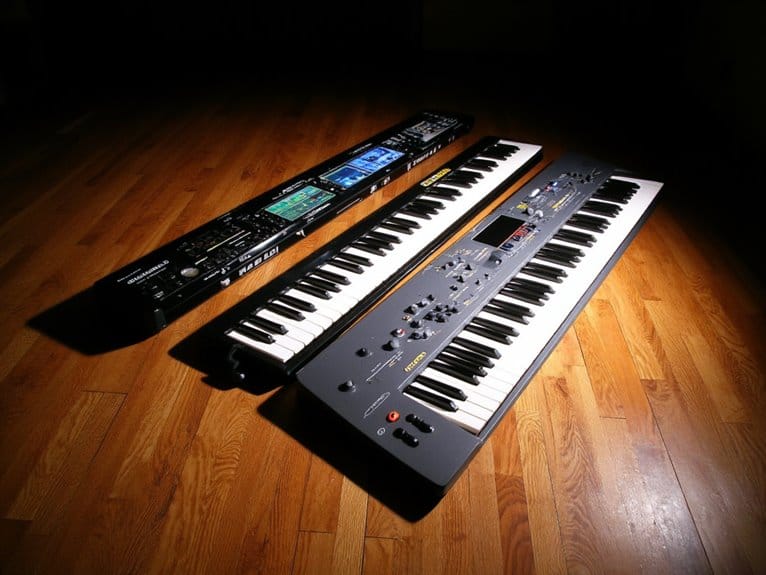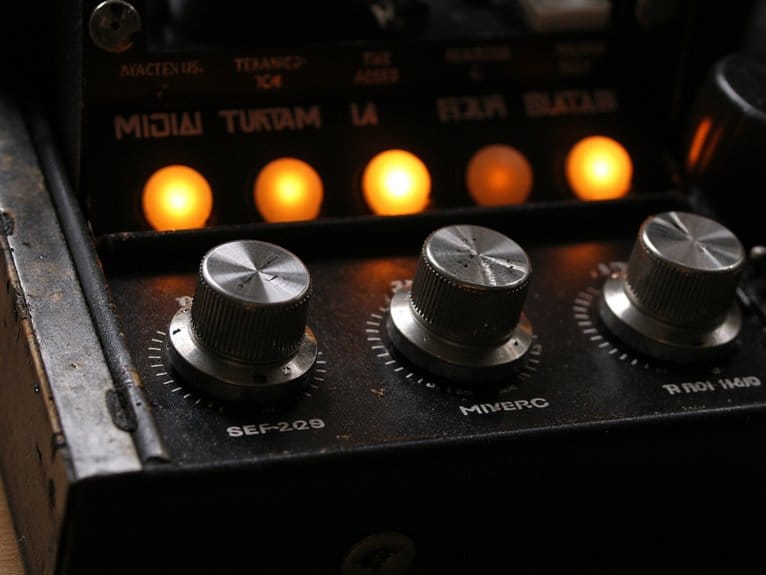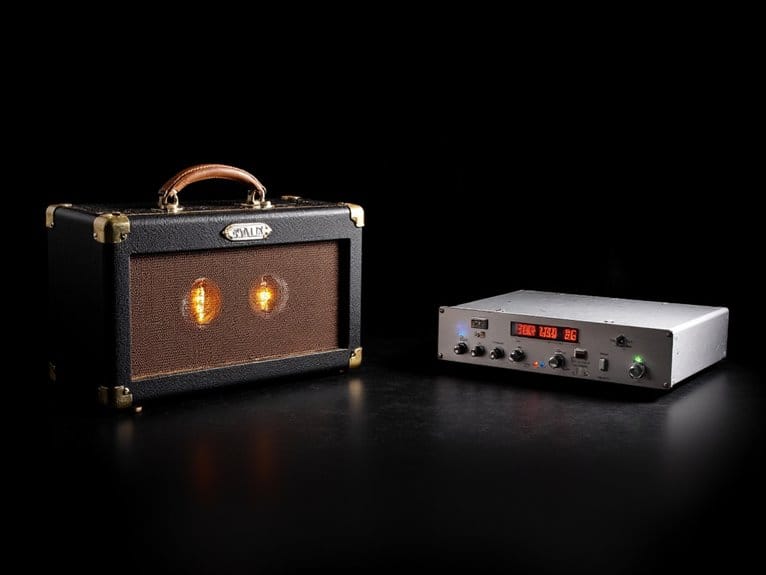Understanding Guitar Body Shapes and Their Sound Characteristics
Guitar body shapes fundamentally determine your instrument’s tonal character, with smaller parlor and double O guitars emphasizing warm midrange frequencies perfect for fingerpicking, while dreadnoughts deliver commanding low-end projection ideal for strumming. Orchestra models and grand concerts bridge intimate playability with dynamic response, whereas grand auditoriums offer exceptional midrange clarity that cuts through any mix. Your playing style, physical comfort, and musical context should guide your selection, as each shape brings distinct sonic personalities that’ll transform your musical expression.
We are supported by our audience. When you purchase through links on our site, we may earn an affiliate commission, at no extra cost for you. Learn more.
Notable Insights
- Smaller guitar bodies emphasize higher frequencies and articulate tones, while larger bodies enhance low-frequency resonance and projection.
- Parlor guitars deliver concentrated, warm sound with midrange emphasis, making them ideal for fingerpicking and blues playing styles.
- Dreadnought guitars provide commanding presence with bold volume, powerful low-end foundation, and exceptional sound projection for versatile performance.
- Orchestra Model and Grand Concert guitars bridge intimate fingerpicking and dynamic strumming with balanced tone and studio-quality articulation.
- Grand Auditorium guitars offer clear, vibrant tones with exceptional midrange clarity, suitable for both fingerpicking and strumming techniques.
The Foundation: How Body Shape Influences Guitar Sound
When I first started examining guitar acoustics seriously, I’ll admit I underestimated how dramatically body shape affects sound—it’s not just about looks, but rather a complex interplay of physics that determines whether you’ll get bright, punchy tones or deep, resonant bass response.
Your guitar’s body fundamentally functions as a resonance chamber, where size and contour dictate frequency emphasis and sound dynamics. Smaller bodies naturally emphasize higher frequencies, producing focused, articulate tones with excellent midrange clarity, while larger bodies enhance low-frequency resonance, delivering that coveted bass depth and overall volume increase. Popular designs like dreadnought and cutaway body shapes each cater to different tonal preferences and playing styles. The dreadnought shape offers a robust sound suitable for various genres, making it particularly favored among players seeking versatile acoustic projection.
The relationship between body dimensions and tonal balance isn’t arbitrary—it’s acoustic engineering at work, determining whether you’ll achieve even frequency distribution or deliberate emphasis on specific ranges. Just as EQ controls on amplifiers allow for sound customization, the physical characteristics of your guitar body provide natural frequency shaping that complements your playing style. When evaluating guitars, always prioritize sound over visual appeal since your ears will ultimately guide you to the right instrument. The soundboard resonance plays a crucial role in amplifying string vibrations and shaping the overall tonal character of your instrument.
Parlor and Double O Guitars: Compact Size, Focused Tone
If you’re seeking an intimate, articulate sound that cuts through the mix without overwhelming your playing space, parlor and double O guitars offer compelling alternatives to their larger counterparts.
These compact body shapes deliver surprisingly rich tonal profiles, with parlor guitars emphasizing warm midrange frequencies and focused clarity that serves fingerstyle players exceptionally well, while double O models provide slightly fuller resonance without sacrificing the controlled, balanced response.
You’ll find both shapes excel at nuanced expression and delicate dynamics, making them ideal choices for recording sessions, couch playing, or any situation where portability and tonal precision matter more than raw volume projection. The parlor guitar’s 12 fret neck joint design contributes to its distinctive woody tone and enhanced upper register accessibility compared to traditional 14-fret configurations.
Parlor Guitar Sound Profile
I’ve spent countless hours playing different guitar body shapes, and parlor guitars consistently surprise me with their ability to deliver such a concentrated, warm sound from such a compact package.
The warm midrange emphasis you’ll experience stems directly from the compact size, which naturally filters out some bass frequencies while highlighting the mid-spectrum tones that cut through a mix beautifully.
When you’re fingerpicking or playing blues, you’ll notice how parlor guitars produce this focused, steady sound with remarkable clarity in those essential middle frequencies.
Wood combinations like solid Sitka spruce tops paired with mahogany back and sides create that characteristic warmth with crisp highs, while cedar tops add unexpected bass presence that’s uncommon in smaller-bodied instruments, giving you more tonal versatility than you’d expect.
The strategic wood combinations used in quality acoustic guitars deliver warm, professional-grade tonal characteristics that enhance the parlor guitar’s natural sound profile.
The body shapes influence sound projection significantly, with parlor guitars favoring midrange emphasis while larger dreadnoughts tend to favor bass response.
Enhanced sustain and responsiveness make these instruments particularly appealing for intimate performances where tonal balance becomes the defining characteristic of your musical expression.
Double O Versatility
Anyone who’s played both parlor and Double O guitars will tell you there’s something special about stepping up to that 14.3-inch lower bout width, and honestly, it’s the versatility that wins me over every time.
The playability comfort comes from that neck positioning about half an inch closer to your body, making those longer sessions feel effortless.
What really impresses me is how these guitars handle multiple musical genres—from blues fingerpicking to folk flatpicking, even early jazz arrangements.
That focused, balanced tone with tighter midrange gives you clarity for complex playing while maintaining enough volume for ensemble work.
You’re getting studio-quality articulation without the bulk, which explains why they’ve remained relevant since the 1930s.
The wood construction materials in these guitars significantly influence their resonant qualities, with maple providing crisp, bright tones while mahogany delivers the warmer, richer sounds that make them particularly effective for jazz applications.
For players with smaller hands, these compact body styles offer excellent comfort since smaller dimensions enhance playability and make it easier to maneuver around the guitar during extended playing sessions.
These guitars often feature solid wood tops that provide superior resonance compared to all-laminate constructions, delivering the rich tonal depth that makes them competitive with much higher-priced instruments.
Orchestra Model and Grand Concert: Balanced Performance for Versatile Players
If you’re seeking a guitar that bridges the gap between intimate fingerpicking and dynamic strumming, the Orchestra Model and Grand Concert body shapes offer that sweet spot of balanced performance that works across multiple musical styles.
These mid-sized guitars, with their carefully engineered proportions and advanced bracing systems, deliver the projection you need for stage work while maintaining the nuanced response that studio musicians and solo performers demand.
You’ll find that both shapes prioritize tonal balance and playability over sheer volume, making them ideal choices when versatility trumps specialization in your musical toolkit.
For beginners exploring these versatile body shapes, many of today’s affordable options feature laminate construction that maintains decent sound quality while offering enhanced durability and portability.
Orchestra Model Features
When you’re evaluating orchestra model guitars, you’ll discover they represent one of the most ingenious compromises in acoustic design, delivering the tonal richness and projection of larger instruments while maintaining the intimate playability that makes them stage-ready performers.
Orchestra Model guitars incorporate sophisticated Acoustic Innovations like cantilevered necks that eliminate traditional heel blocks, greatly enhancing body strength while elevating overall performance.
Advanced Soundboard Features include asymmetrically positioned drop ports that maximize radiating surface area, delivering enhanced low-end power without muddiness.
Playing Comfort benefits from compact dimensions that facilitate easier handling during extended performances.
Construction Techniques employ proprietary T-fan bracing patterns achieving remarkably low soundboard mass around 58 grams.
Design Elements feature external tuning slots for fine resonance adjustment.
Tonal Balance emerges from carefully optimized bracing systems. Understanding these systems helps musicians make informed decisions when considering instruments like resonator guitars, which utilize hand-spun cones for superior sound quality compared to machine-pressed alternatives.
Material Choices typically include solid Sitka spruce tops with mahogany necks. The mahogany construction provides warm tones and superior resonance that complement the balanced performance characteristics of orchestra models.
Similarly, hollow body electric guitars utilize quality materials like mahogany and maple to ensure exceptional resonance and durability while producing warm, versatile tones suitable for jazz, blues, and rock genres.
Grand Concert Characteristics
The Grand Concert represents perhaps the most thoughtfully engineered balance between intimacy and projection in the acoustic guitar world, delivering sophisticated tonal characteristics that’ll make you wonder why anyone needs a larger body shape for most musical applications.
With body dimensions measuring approximately 19.5 inches long and 15 inches wide, you’ll experience exceptional fingerstyle comfort through its slightly wider neck and shorter scale length. The construction materials, typically featuring Sitka spruce tops with rosewood or mahogany backs, enhance tonal clarity while maintaining controlled overtones.
You’ll appreciate the dynamic response across various playing styles, from delicate fingerpicking to moderate strumming. The playability features, combined with forward-shifted bracing patterns, deliver impressive sound projection that fits beautifully in studio recordings and ensemble settings. Orchestra shapes like these provide balanced tonal characteristics that complement both solo performance and ensemble work.
Martin’s Road Series 000-10E exemplifies this body style’s capabilities with its solid sapele construction that produces rich tones and strong bass response in the auditorium-sized design.
While traditionally associated with acoustic guitars, hollow body electric guitars offer similar tonal benefits with their resonant chambers, making them equally versatile across jazz, blues, and contemporary genres.
Versatile Playing Applications
Experienced players often discover that Orchestra Model and Grand Concert guitars represent the sweet spot where technical precision meets musical versatility, delivering performance characteristics that’ll handle everything from intimate fingerstyle sessions to full-band arrangements without breaking a sweat.
Your playing comfort improves dramatically with these compact body dimensions, as the 15″ width and moderate depth reduce fatigue during extended sessions while maintaining excellent projection. The musical adaptability shines through their balanced frequency response, where scalloped bracing and quality tonewoods create clarity across all registers without sacrificing warmth.
| Playing Style | Performance Quality |
|---|---|
| Fingerstyle | Excellent clarity and note separation |
| Flatpicking | Responsive attack with smooth highs |
| Ensemble Work | Balanced projection without overpowering |
Whether you’re tackling complex classical arrangements or driving bluegrass rhythms, these guitars adapt seamlessly to your technique and musical demands. For guitarists seeking to expand their sonic palette beyond traditional acoustic tones, guitar synth pedals offer compact solutions that transform standard instruments into synthesizer sounds without modifications. The smaller body size also makes these guitars particularly appealing for travel musicians who need reliable instruments that won’t compromise performance quality during transport. Similar to how quality microphones capture the full tonal spectrum with a 20 Hz to 20 kHz frequency response for wind instruments, these guitar body shapes excel at reproducing the complete harmonic range that makes acoustic instruments shine in both recording and live performance settings.
Dreadnought Guitars: Power, Projection, and Bold Sound
Most guitarists I’ve encountered can instantly recognize a dreadnought’s commanding presence the moment someone strikes those first bold chords, and there’s good reason this body shape has dominated acoustic guitar manufacturing for nearly a century.
You’ll immediately notice the dreadnought’s exceptional sound projection, which stems from its substantial 16″ width and 20″ length dimensions that create unmatched volume output. The tonal characteristics deliver a powerful low-end foundation with snappy top-midrange clarity, making these guitars ideal for aggressive flatpicking and strumming techniques.
Their balanced EQ response includes a subtle midrange scoop that complements vocal frequencies beautifully, while the straighter body profile maintains clarity even during hard playing, ensuring your sound cuts through any mix with remarkable precision. When selecting a dreadnought, prioritize solid wood construction over laminated alternatives, as this ensures superior resonance, sustain, and long-term playability that fully capitalizes on the body shape’s natural acoustic advantages.
Grand Auditorium and Grand Pacific: Modern Versatility Meets Classic Warmth
While dreadnoughts command attention through sheer power, I’ve found that Taylor’s Grand Auditorium and Grand Pacific body shapes represent a more nuanced approach to acoustic guitar design, each offering distinct sonic personalities that cater to modern players seeking versatility without sacrificing tonal character.
The Grand Auditorium excels as Taylor’s quintessential workhorse, delivering clear, vibrant tones with exceptional midrange clarity that cuts through any musical mix, making it perfect for players who frequently switch between fingerpicking and strumming techniques.
Meanwhile, the Grand Pacific embraces warmth through its round-shoulder dreadnought design and V-Class bracing, producing rich, blended tones where notes overlap smoothly rather than standing in stark separation, creating that seasoned, bluesy character many guitarists crave for intimate performances.
Classical and Nylon String Guitars: Mellow Resonance and Intimate Expression
When you pick up a classical guitar for the first time, you’ll immediately notice how different it feels from its steel-string counterparts. That tactile difference translates directly into a sound that’s fundamentally more intimate and contemplative.
The nylon characteristics create that signature warm, rounded tone that’s perfect for chamber music or solo performances. The wider neck—typically 52mm at the nut—gives you the string spacing needed for complex fingering patterns. Classical guitars excel with fingerstyle technique, encouraging delicate plucking rather than aggressive strumming.
The traditional Torres-inspired body shape, combined with spruce or cedar tops, maximizes the gentle resonance that nylon strings produce, creating an instrument that’s designed for nuanced expression rather than projection volume.
Choosing the Right Body Shape for Your Playing Style and Physical Comfort
Beyond the sonic characteristics I’ve covered, your choice of guitar body shape ultimately comes down to a deeply personal equation that balances your playing style, physical dimensions, and the musical contexts where you’ll use the instrument most often.
If you’re primarily a fingerstyle player, smaller bodies like Parlor or Grand Concert offer superior clarity and articulation, while comfort considerations favor these shapes for extended playing sessions. Strummers benefit from Dreadnought or Jumbo bodies that deliver powerful bass response and projection.
Body shape suitability extends beyond sound—your physical frame, arm length, and preferred playing position greatly impact which guitar feels natural. I always recommend trying instruments in person, as comfort and playability can vary dramatically between individual players.
Frequently Asked Questions
Do Different Wood Types Change How Body Shape Affects Guitar Tone?
Yes, tone woods dramatically alter how your guitar’s body shape affects sound. Wood density changes body resonance patterns, while harder woods amplify acoustic impact from shape characteristics and softer woods mellow those tonal distinctions.
How Does String Gauge Interact With Body Shape to Influence Sound?
String tension from your gauge choice directly affects tone balance across different body shapes. Heavier strings on larger bodies enhance harmonic resonance and low-end warmth, while lighter gauges suit your playing style on smaller guitars.
How Do Humidity and Temperature Changes Affect Different Body Shapes Differently?
Your hollow body guitars experience severe humidity effects from thin wood construction, causing warping and action changes. Solid bodies show greater temperature sensitivities in electronics while resisting major structural distortion due to thicker wood blocks.
On a final note
Understanding your guitar’s body shape isn’t just about aesthetics—it’s about finding your voice as a musician. Whether you’re drawn to the intimate warmth of a parlor guitar, the booming projection of a dreadnought, or the balanced versatility of a grand auditorium, each shape offers distinct tonal characteristics that’ll complement different playing styles. Take time to play various models, trust your ears, and choose what feels right for you.

